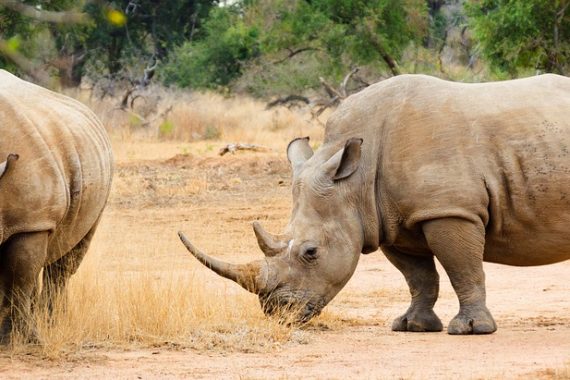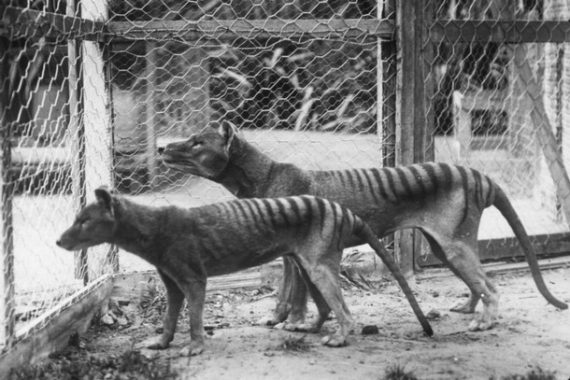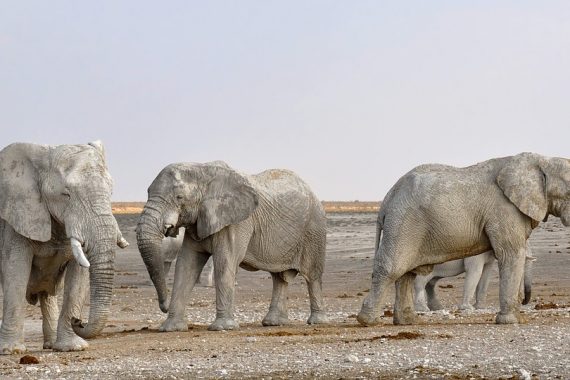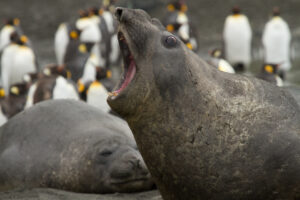
The impressive Elephant Seal (image from https://www.inaturalist.org/taxa/41729-Mirounga-leonina)
They may not be as large as actual elephants, but Elephant seals are certainly large, topping the list as the largest extant carnivores. The Southern Elephant Seal subspecies is the largest pinniped on the planet and can live as long as 22 years! Their relative, the Northern Elephant Seal is smaller, and generally only live 9 years maximum. They are named Elephant seals for the distinctive proboscis of the adult male, or bull, which closely resembles the trunk of an Elephant. These huge inflatable noses are utilised in the winter breeding season, creating loud noises the males use to threaten each other.
These marine mammals are classified under the order Pinnipedia and considered true seals, falling into the Phocidae family. True seals, or phocids, are characterised by having no external ears and reduced limbs, which helps them to move more easily and streamlined in the water.
Northern Elephant Seals (Mirounga angustirostris) can be found in the Eastern and Central regions of the North Pacific Ocean, ranging as far North as Alaska. Usually breed and give birth in the warmer climes of the waters off California or Mexico, resting on offshore islands. The Southern Elephant Seals (Mirounga leonina) are found around the Subantartic Islands, with the largest population residing in South Georgia. Occasionally, they are rare reports of Elephant Seal births in New Zealand, Australia and South Africa.
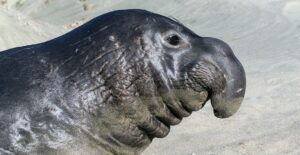
The huge nose of the Elephant Seal, used to bellow at other males during breeding season (image from https://www.nhm.ac.uk/discover/news/2019/may/elephant-seals-a-giant-survival-story.html)
Life on the waves
Elephant seals are almost entirely aquatic, spending up to 80% of their lives in the ocean, capable of holding their breath for up to 100 minutes, far longer than any other marine mammal, with the exception of whales. In a single day, they can travel up to 60 miles when they head out into the ocean, and have been recorded diving to depths of 1550 metres, foraging for deep ocean species, like lanternfish, hake and ragfish, and even fast moving squid in some cases. They will often go after sea floor species like skates, rays, octopi, eels and small sharks if they’re feeling particularly hungry.
The oceans elephants seals call home are freezing cold, and they have several adaptations to stave of these chilly temperatures. They have a thick layer of blubber that shields them from the cold, although when they molt, losing their fur, they must regrow it using blood vessels that reach through the blubber. During this time, the seals are susceptible to the cold waters, and must find a spot to rest on land, called a ‘haul-out.’ This generally occurs during June and July.
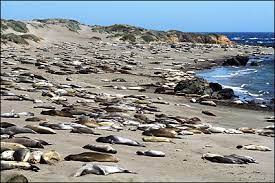
A popular haul out site for a group of elephant seals (image from http://earthguide.ucsd.edu/elephantseals/conservation/index.html)
Elephants seals are also capable of slowing their heartbeat down to very few beats per minute, a biological process called bradycardia, and divert vital blood flow away from the body’s extremities to the core organs, essential on their incredibly deep dives into icy waters. High blood volumes also enable the seals to hold larger amounts of oxygen for these deep dives and all this blood is held in large cavities in their abdomens. Their muscles also contain higher levels of myoglobin, and iron and oxygen binding protein found in cardiac and skeletal muscle, that helps them store more oxygen in their muscle fibres. On top of this, they have a higher percentage of red blood cells, another physiological adaptation for them to store even more oxygen. When they dive, they also slow down their metabolism almost to a halt, saving as much energy as possible to ensure they get back to the surface safely.
Its also very dark down in the depths, so Elephant seals also have very large circular eyes packed full of cone cells that help them see in low light. They also have the tapetum lucidum, a reflective membrane at the back of the eye, seen in cats that gives them that characteristic eye shine in the dark. This membrane reflects light back to the retina, giving more light for photoreceptors to detect what limited light there is in the dark ocean.
They may be part of the group called the earless seals, but their internal ears have evolved to become an incredible tool for underwater lifestyles. The structure of the ear canal has evolved to amplify incoming sounds and give the seals excellent directional hearing. The tissues in their inner ears are also adapted to adjust the pressure in the ear canal when the seals dive, essential at the crushing depths the seals can reach.
A troubled history and a successful rebound: the conservation story of the Elephant Seal
At the end of the 19th Century, Elephant seals were hunted almost to the brink of extinction for their oil rich blubber, used to make oil for lamps and lubrication of machines. By 1884, the species was declared extinct.
However in 1892, a tiny population of northern elephant seals was rediscovered clinging to life near Mexico, and from this the species began to slowly rebuild. In the early twentieth century, the species was protected under law in America and Mexico, and today the population is up to 150,000 individuals. The Southern Elephants seals were just as heavily hunted as the Northern subspecies, again, with a little protection, the current population is now estimated at 650,000 individuals, and despite some recent declines as the populations stabilise, the species is now considered stable. Although they are doing well today, Elephant seals have very low genetic diversity as consequence of the catastrophic declines they experienced. This is down to a phenomenon called a genetic bottleneck. When a population drastically declines, the amount of genetic variation is also drastically reduced as there are less individuals to breed, resulting in inbreeding. Less genetic diversity means that a species can’t adapt as successfully to changing conditions, as the genetic variation that natural selection would act on has been removed from the population, through a process called genetic drift. Although this bottleneck happened over 100 years ago, the hall marks of this can still be seen in the Elephant seal genome today. Northern seals were more intensely hunted than the Southern seals, and this is reflected in their genetics today, with the Southern Elephant seal displaying far more genetic diversity than their Northern relatives.
Although the IUCN lists the species as least concern, they still face threats from marine pollution, ingestion of plastics and disturbance to breeding colonies. Commercial fishing threatens Elephant seals as it does with so many marine species, entangling them in nets and longlines and depleting their food supplies.
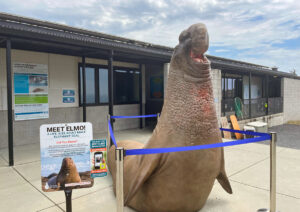
A life size model of an Elephant Seal, called Elmo, that was displayed outside of the Marine Mammal Centre
But the Elephant Seals are by no means a neglected species. The Marine Mammal Centre, headquartered in California, works to save and conserve not just the Elephant Seal but other pinnipeds and cetaceans too. They have rescued 24,000 marine mammals since 1975 with the help of dedicated volunteers and vets, who care for the animals until they are ready for release. They also use their state of the art care facilities to research new veterinary techniques in marine mammal rehab, as well as behavioural and ecological research to improve outcomes for marine mammals in the wild. They also have a range of educational programmes to teach children about the importance of ocean stewardship and hands on activities like beach cleans. You can learn all about their amazing work at The Marine Mammal Center | Home.

Awesome videos!
References
Antonellis, G.A. Lowry, M.S. DeMaster, D.P. and Fiscus, C.H. (1987) ‘Assessing the Northern Elephant Seal feeding habits by stomach lavage.’ Marine Mammal Science
DeLong, R.L. and Stewart, B.S. (1991) ‘Diving patterns of northern elephant seal bulls.’ Marine Mammal Science
Hoelzel, A.R. (1998) ‘Impact of population bottlenecks on genetic variation and the importance of life-history; a case study of the northern elephant seal.’ Biological Journal of the Linnean Society
Hoelzel, A.R. Halley, J. O.Brien, S.J. Campagna, C. Arnborm, T. Le Boeuf, B. Ralls, K. and Dover, G.A. (1993) ‘Elephant seal genetic variation and the use of simulation models to investigate historical population bottlenecks.’ Journal of Heredity
Elephant seal – Australian Antarctic Program (antarctica.gov.au)
Elephant Seals | National Geographic
MASSIVE THANK YOU TO RACHAEL DA SILVA FROM THE UK FOR THIS WRITE UP! PLEASE FOLLOW HER ON INSTAGRAM AND HER WILDLIFE ARTWORK AT TILLY_MINT08


